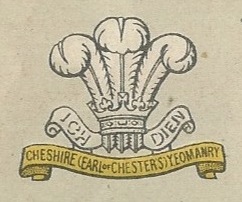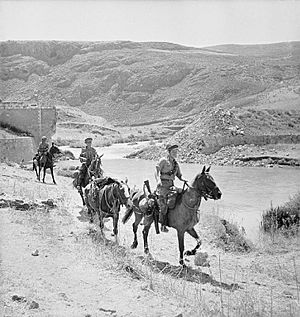Cheshire Yeomanry facts for kids
Quick facts for kids The Cheshire Yeomanry |
|
|---|---|

Cap badge
|
|
| Active | 1797–present |
| Country | |
| Branch | |
| Type | Yeomanry |
| Role | Formation Reconnaissance Signals |
| Size | Two Squadrons |
| Part of | Royal Armoured Corps Royal Signals |
| Garrison/HQ | Chester |
| March | Quick - |
| Engagements | Peterloo Massacre Second Boer War First World War
|
| Battle honours | See battle honours below |
| Commanders | |
| Honorary Colonel | Major Peter M. Cooper, TD |
| Notable commanders |
Hugh Grosvenor, 2nd Duke of Westminster |
The Cheshire Yeomanry was a special type of army unit called a yeomanry regiment. It has a long history, starting way back in 1797.
It was first formed when a man named Sir John Leicester created a group of light cavalry soldiers. This was because people were worried about an invasion from Napoleon's France. Today, a part of the Queen's Own Yeomanry continues the traditions of the Cheshire Yeomanry.
Contents
History
How it Started
The Cheshire Yeomanry began in 1797. Sir John Leicester formed the unit to protect the county of Cheshire. They were light cavalry, meaning soldiers who rode horses.
In 1803, the Prince of Wales, who later became King George IV, gave them special permission. They could wear his triple feather crest as their badge. Cheshire Yeomanry soldiers still wear this badge today.
The Peterloo Massacre
On August 16, 1819, the Cheshire Yeomanry was involved in an event known as the Peterloo Massacre. This happened at a public meeting in Manchester, England. Cavalry soldiers charged into a large crowd.
Sadly, eleven people died and over 400 were hurt. Many of those injured were women and children. The Cheshire Yeomanry was one of several military units present that day.
The Second Boer War
Yeomanry units were not usually sent to fight overseas. However, in 1899, the British Army needed more soldiers for the Second Boer War in South Africa. The government asked volunteer forces to help.
The Cheshire Yeomanry sent two companies of about 115 men each. These soldiers fought as mounted infantry, meaning they rode horses but fought on foot. This experiment was successful. In 1901, the regiment changed its name to the Cheshire Imperial Yeomanry.
The First World War
When the First World War began in 1914, the Territorial Force, which the Yeomanry was part of, was meant for home defence. But many soldiers volunteered to fight overseas. So, units were split into "1st Line" for overseas service and "2nd Line" for home service. A "3rd Line" was later formed to train new soldiers.
1st Line: Fighting Overseas
The 1/1st Cheshire Yeomanry went to Egypt in March 1916. They were dismounted, meaning they no longer fought on horseback. In 1917, they joined with another unit to form the 10th (Shropshire and Cheshire Yeomanry) Battalion.
This new battalion became part of the 74th (Yeomanry) Division. They fought in the invasion of Palestine. Key battles included the Second and Third Battles of Gaza. They also helped capture Jerusalem.
In May 1918, the battalion moved to France. They learned about trench warfare and gas defence for the Western Front. They took part in the Hundred Days Offensive, including the Second Battle of the Somme. The war ended with them near Tournai, Belgium. The unit was officially disbanded in July 1919.
2nd Line: Home Defence
The 2nd Line regiment was formed in 1914. They stayed in the United Kingdom, mainly in Northumberland and East Anglia. Their job was to defend the home country.
In 1916, most Yeomanry units were changed into cyclists. So, the 2/1st Cheshire Yeomanry became a cyclist unit. They moved to Ireland in 1918 and remained there until the war ended.
3rd Line: Training New Soldiers
The 3rd Line regiment was formed in 1915. Their main role was to train new soldiers. These new recruits would then join the 1st or 2nd Line units. This unit was disbanded in early 1917.
Between the Wars
After the First World War, the army decided that cavalry (horse-mounted soldiers) were not as important anymore. Many Yeomanry regiments were changed into other types of units. The Cheshire Yeomanry was one of the few that stayed as a horse-mounted cavalry unit for a while.
The Second World War
During the Second World War, the Cheshire Yeomanry was still a mounted regiment. They served in Palestine, Syria, and the Lebanon. They were one of the last British Army regiments to fight on horseback.
In 1942, they changed their role and became a Signals Regiment. This meant they focused on communications. They were renamed the 5th Line of Communications Signals Regiment. Later, they became the 17th Line of Communication Signals Regiment for service in North-West Europe.
After the Wars
In 1947, the Cheshire Yeomanry became an armoured regiment. They used Cromwell and Comet tanks. Later, in 1958, they used Daimler Armoured Cars.
In 1967, the regiment was mostly disbanded. But in 1971, the Queen's Own Yeomanry (QOY) was formed. It included parts of the Cheshire Yeomanry. In 1999, they joined the Royal Mercian and Lancastrian Yeomanry.
The Royal Mercian and Lancastrian Yeomanry
This unit's job was to provide reserve soldiers for the regular army's Challenger 2 tanks. In 2014, C (Cheshire Yeomanry) Squadron, based in Chester, rejoined the Queen's Own Yeomanry.
33 (Lancashire and Cheshire) Signal Regiment
Another part of the Cheshire Yeomanry continues today. It is the 80th (Cheshire Yeomanry) Signal Squadron (V). This squadron is part of the 33 Signal Regiment, which belongs to the Royal Signals.
Regimental Museum
You can learn more about the Cheshire Yeomanry at the Cheshire Military Museum. It is located at Chester Castle.
Battle Honours
Battle honours are special awards given to military units for their bravery in battles. The Cheshire Yeomanry earned many of these. The ones in bold are displayed on their regimental flags.
| Second Boer War | South Africa 1900–01 |
| First World War | Somme 1918, Bapaume 1918, Hindenburg Line, Épehy, Pursuit to Mons, France and Flanders 1918, Egypt 1916–17, Gaza, Jerusalem, Jericho, Tell 'Asur, Palestine 1917–18 |
| Second World War | Syria 1941
Honorary Distinction: Badge of the Royal Corps of Signals with year-date "1945" and scroll "North-West Europe" |
Uniforms
Before World War I, the Cheshire Yeomanry wore a fancy uniform. It looked like the uniforms of regular British Army hussar regiments. Their dark blue jacket had white braiding and piping.
They wore a peaked cap, but sometimes used fur hats called busbies for special events. From about 1907, they started wearing a plain khaki service uniform. This replaced the blue uniform for most occasions after 1914. After 1942, when they stopped using horses, they wore standard British Army uniforms.
See also
- Imperial Yeomanry
- List of Yeomanry Regiments 1908
- Yeomanry
- Yeomanry order of precedence
- British yeomanry during the First World War
- Second line yeomanry regiments of the British Army


